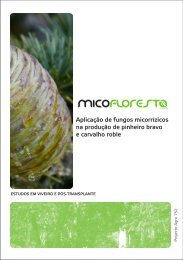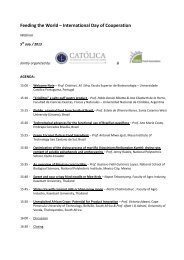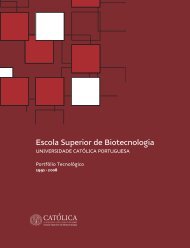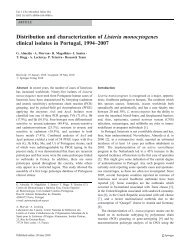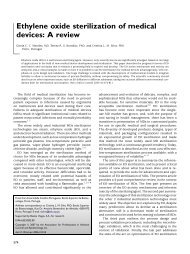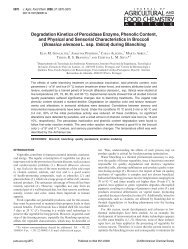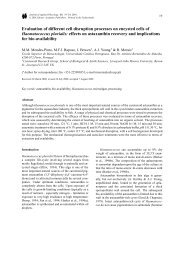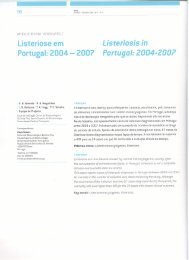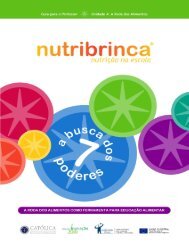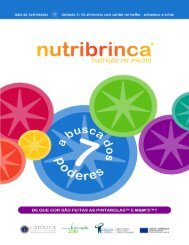On the Utilization of Microalgae for Brewery Effluent Treatment and ...
On the Utilization of Microalgae for Brewery Effluent Treatment and ...
On the Utilization of Microalgae for Brewery Effluent Treatment and ...
You also want an ePaper? Increase the reach of your titles
YUMPU automatically turns print PDFs into web optimized ePapers that Google loves.
ABSTRACT<br />
<strong>On</strong> <strong>the</strong> <strong>Utilization</strong> <strong>of</strong> <strong>Microalgae</strong> <strong>for</strong> <strong>Brewery</strong><br />
<strong>Effluent</strong> <strong>Treatment</strong> <strong>and</strong> Possible Applications<br />
<strong>of</strong> <strong>the</strong> Produced Biomass<br />
M. Filomena de J. Raposo 1 , Susana E. Oliveira 1 , Paula M. Castro 1 ,<br />
J. Inst. Brew. 116(3), 285–292, 2010<br />
The effluent <strong>of</strong> a brewery, complete or diluted with deionised<br />
water or with normal culture medium, was used as <strong>the</strong> growth<br />
nutrient medium <strong>for</strong> Chlorella vulgaris <strong>and</strong> <strong>for</strong> a consortium<br />
obtained from <strong>the</strong> autochthonous flora <strong>of</strong> that effluent (microalgae,<br />
cyanobacteria <strong>and</strong> bacteria). The cultures were exposed to<br />
continuous light <strong>and</strong> aeration, at 25°C, <strong>and</strong> growth was evaluated<br />
by direct counting (C. vulgaris) or by chlorophyll determination<br />
(autochthonous flora). Total protein <strong>and</strong> lipid content, <strong>and</strong><br />
amino acid <strong>and</strong> fatty acid pr<strong>of</strong>iles in <strong>the</strong> produced biomass were<br />
determined. The highest removal rate <strong>of</strong> nutrients present in <strong>the</strong><br />
effluent was obtained when <strong>the</strong> complete effluent was used as<br />
<strong>the</strong> culture medium <strong>for</strong> <strong>the</strong> autochthonous flora – up to 5,855 g<br />
kg –1 biomass d –1 <strong>of</strong> nitrogen <strong>and</strong> up to 805 g kg –1 biomass d –1 <strong>of</strong><br />
phosphate. A reduction <strong>of</strong> up to 27% in biological oxygen dem<strong>and</strong><br />
(BOD5, initial level <strong>of</strong> 2,172 mg O2 L –1 ) <strong>and</strong> up to 15% in<br />
chemical oxygen dem<strong>and</strong> (COD, initial level <strong>of</strong> 1,340 mg O2 L –<br />
1 ) was observed in cultures <strong>of</strong> <strong>the</strong> autochthonous flora grown in<br />
different loads <strong>of</strong> effluent. A significant increase in aspartic acid,<br />
glutamic acid <strong>and</strong> valine content, <strong>and</strong> a higher level <strong>of</strong> <strong>the</strong> ramified<br />
fatty acids, <strong>of</strong> <strong>the</strong> 14:0isobr, 18:4ω3, <strong>and</strong> <strong>the</strong> eicosapentaenoic<br />
acid, were found in <strong>the</strong> final biomass obtained from<br />
cultures grown with different loads <strong>of</strong> effluent, compared with<br />
<strong>the</strong> results obtained <strong>for</strong> <strong>the</strong> cultures grown in normal nutrient<br />
medium. The final microalgae biomass obtained, considering its<br />
protein <strong>and</strong> fatty acid content <strong>and</strong> <strong>the</strong> absence <strong>of</strong> heavy metals in<br />
significant amount, can be appropriate <strong>for</strong> use as animal feed or<br />
<strong>for</strong> bi<strong>of</strong>uel production.<br />
Key words: autochthonous flora, biological treatment, biomass<br />
valorisation, brewery wastewater, Chlorella vulgaris.<br />
INTRODUCTION<br />
The high organic load <strong>of</strong> effluents originating from different<br />
industries, namely those from <strong>the</strong> agro-food industries,<br />
is a major environmental problem. Among <strong>the</strong>se,<br />
1 Escola Superior de Biotecnologia – Universidade Católica Portuguesa,<br />
Rua Dr. António Bernardino de Almeida, 4200-072 Porto –<br />
Portugal.<br />
2 INIAP/IPIMAR, DITVPP Av. Brasília, 1449-006 Lisboa – Portugal.<br />
* Corresponding author. E-mail: rmmorais@esb.ucp.pt<br />
Publication no. G-2010-1020-1085<br />
© 2010 The Institute <strong>of</strong> Brewing & Distilling<br />
Narcisa M. B<strong>and</strong>arra 2 <strong>and</strong> Rui M. Morais 1,*<br />
effluents derived from <strong>the</strong> dairy <strong>and</strong> brewery sectors are<br />
rich in organic compounds, such as proteins, phosphates,<br />
ammonia <strong>and</strong>/or nitrate, which must be removed from <strong>the</strong><br />
residual waters be<strong>for</strong>e discharging into <strong>the</strong> environment.<br />
In addition, brewery effluent is usually composed <strong>of</strong> sugars,<br />
soluble starch, ethanol <strong>and</strong> volatile fatty acids, which<br />
are easily biodegradable 10 .<br />
There are several technologies associated with <strong>the</strong><br />
treatment <strong>of</strong> effluents derived from <strong>the</strong> agro-food industries,<br />
such as physical, chemical, or biological, to remove<br />
<strong>the</strong> organic <strong>and</strong> inorganic nutrients, such as nitrogen (ammonia<br />
or nitrate) <strong>and</strong> phosphorus 27,32 , as is <strong>the</strong> case <strong>of</strong><br />
high rate ponds 24 . Most <strong>of</strong> <strong>the</strong> biological treatment technologies<br />
involve <strong>the</strong> use <strong>of</strong> bacteria, but microalgae have<br />
already been applied <strong>for</strong> effluent treatment, ei<strong>the</strong>r as single<br />
species, as is <strong>the</strong> case <strong>of</strong> Chlorella, Scenedesmus or<br />
Arthrospira 18,21,22,23,33 , or as mixed cultures/consortia 22,25,30 ,<br />
to treat <strong>and</strong> remove nitrogen, phosphorus <strong>and</strong> chemical<br />
oxygen dem<strong>and</strong>, from different types <strong>of</strong> effluents, such as<br />
dairy manures 22 , or wastewaters from <strong>the</strong> wood-based<br />
pulp <strong>and</strong> paper industry 30 , or olive-mill residues 28 .<br />
These organisms are also able to remove <strong>and</strong> incorporate<br />
heavy metals, such as lead 2 , cadmium, nickel or mercury<br />
6,31 , present in effluents, <strong>and</strong> <strong>the</strong>ir use could be potentially<br />
more widespread. <strong>Microalgae</strong> also produce oxygen<br />
<strong>for</strong> bacterial decomposition <strong>of</strong> organic matter, <strong>and</strong> can<br />
play an important role in removing pathogenic bacteria<br />
through <strong>the</strong>ir bactericide action 9 . Moreover, <strong>the</strong> biomass<br />
produced can be used as animal feed (fish <strong>and</strong> shellfish,<br />
ar<strong>the</strong>mia or rotifers), as fertilizer to enrich soils with nutrients<br />
26 or fixing particles, or even <strong>for</strong> extracting valuable<br />
compounds, such as pigments 28 , enzymes 5 or antibiotics.<br />
Among <strong>the</strong> several microalgae used to treat effluents<br />
Chlorella is <strong>of</strong>ten found, as it is known <strong>for</strong> a long time<br />
that some species <strong>of</strong> this algae are able to grow in a<br />
mixotrophic environment 17 ; but scarce in<strong>for</strong>mation is<br />
available on <strong>the</strong> use <strong>of</strong> autochthonous organisms, from <strong>the</strong><br />
various types <strong>of</strong> wastewaters.<br />
In this study, <strong>the</strong> potential use <strong>of</strong> a brewery effluent as<br />
a nutrient medium <strong>for</strong> microalgae growth was evaluated,<br />
resulting in <strong>the</strong> production <strong>of</strong> biomass, valuable <strong>for</strong> its<br />
composition, <strong>and</strong> amenable to be used as fertilizer or as<br />
feed <strong>for</strong> fish or o<strong>the</strong>r small animals. In addition, <strong>the</strong> capacity<br />
<strong>of</strong> C. vulgaris <strong>and</strong> <strong>the</strong> autochthonous flora <strong>of</strong> <strong>the</strong><br />
effluent to remove some <strong>of</strong> <strong>the</strong> compounds present in <strong>the</strong><br />
effluent was analysed.<br />
VOL. 116, NO. 3, 2010 285
MATERIALS AND METHODS<br />
Biological material<br />
C. vulgaris <strong>and</strong> a consortium (microalgae, cyanobacteria<br />
<strong>and</strong> bacteria) obtained from <strong>the</strong> autochthonous flora <strong>of</strong><br />
a brewery effluent were used as described below.<br />
Isolation <strong>and</strong> growth <strong>of</strong> <strong>the</strong> microalgae<br />
C. vulgaris <strong>and</strong> Arthrospira (Spirulina) platensis were<br />
tested separately <strong>for</strong> growth in <strong>the</strong> referred effluent. <strong>On</strong>ly<br />
<strong>the</strong> <strong>for</strong>mer was able to grow <strong>and</strong> thus was used as a control<br />
against <strong>the</strong> autochthonous consortium (microalgae,<br />
cyanobacteria <strong>and</strong> bacteria). The so-called autochthonous<br />
flora was isolated from <strong>the</strong> brewery effluent after filtration<br />
with glass filters GF/C Whatman, n°1822047, porosity:<br />
fine. The material retained in <strong>the</strong> filter was inoculated<br />
onto OHM (Optimal Haematococcus Medium) <strong>and</strong> BG<br />
(Blue-Green Medium – cyanobacteria) media, both with<br />
<strong>and</strong> without nitrate, to promote <strong>the</strong> growth <strong>of</strong> <strong>the</strong> microalgae<br />
possibly present, including some cyanobacteria that<br />
are able to fix nitrogen from <strong>the</strong> air, <strong>and</strong> thus are easily<br />
isolated in <strong>the</strong> absence <strong>of</strong> nitrate. The autochthonous flora<br />
obtained in BG medium was used as <strong>the</strong> inoculum <strong>for</strong> <strong>the</strong><br />
experiments with <strong>the</strong> effluent. C. vulgaris was previously<br />
isolated in this laboratory from a waste discharge container<br />
<strong>and</strong> identified by <strong>the</strong> Department <strong>of</strong> Botany <strong>of</strong> <strong>the</strong><br />
University <strong>of</strong> Coimbra21 . The microalgae was kept in<br />
OHM medium until required <strong>for</strong> use.<br />
Cultures <strong>of</strong> C. vulgaris <strong>and</strong> <strong>the</strong> isolated consortium<br />
were established using <strong>the</strong> brewery effluent, <strong>and</strong> using<br />
OHM <strong>for</strong> C. vulgaris <strong>and</strong> BG <strong>for</strong> <strong>the</strong> consortium obtained<br />
from <strong>the</strong> effluent. All <strong>the</strong> experiments were carried out in<br />
a walk-in chamber, at constant temperature (25°C) <strong>and</strong><br />
illumination (37 μE s –1m –2 ) with cool white fluorescent<br />
lamps. The consortium was composed <strong>of</strong> green microalgae,<br />
cyanobacteria <strong>and</strong> bacteria. The main organisms present<br />
were identified by optical microscopy as Chlorella,<br />
Scenedesmus, Oedogonium, diatoms, <strong>and</strong> Anabaena. Oedogonium<br />
is not usually referred to as a microalgae.<br />
Growth media<br />
The OHM medium ingredients were as follows: KNO 3,<br />
0.4 g L –1 ; Na 2HPO 4, 0.03 g L –1 ; MgSO 4, 0.12 g L –1 ; CaCl 2,<br />
0.11 g L –1 ; EDTA, 0.006 g L –1 ; CoCl 2·6H 2O, 0.012 mg L –1 ;<br />
CuSO 4·5H 2O, 0.012 mg L –1 ; CrO 3, 0.076 mg L –1 ;<br />
MnCl 2·4H 2O, 1.12 mg L –1 ; Na 2MoO 4·2H 2O, 0.121 mg L –1 ;<br />
SeO 2, 0.006 mg L –1 ; <strong>and</strong> vitamins thiamine chloride hydrochloride,<br />
0.175 mg L –1 ; B12, 0.15 mg L –1 <strong>and</strong> H, 0.25<br />
mg L –1 .<br />
Two parts comprised <strong>the</strong> BG medium. Part I was prepared<br />
with NaCl, 35 g L –1 ; tricine, 0.5 g L –1 ; NaNO 3, 0.11<br />
g L –1 ; KH 2PO 4, 0.005 g L –1 ; Na 2HPO 4, 0.0045 g L –1 ;<br />
H 3BO 3, 2.86 mg L –1 ; MnCl 2·4H 2O, 1.81 mg L –1 ;<br />
ZnSO 4·7H 2O, 0.222 mg L –1 ; Na 2MoO 4·2H 2O, 0.39 mg L –1 ;<br />
CuSO 4·5H 2O, 0.079 mg L –1 ; Co(NO 3) 2·6H 2O, 0.049 mg L –1<br />
(pH 7.6–7.8). Part II was composed <strong>of</strong> NaNO 3, 1.5 g L –1 ;<br />
MgSO 4·7H 2O, 0.075 g L –1 ; K 2HPO 4·3H 2O, 0.04 g L –1 ;<br />
CaCl 2·2H 2O, 0.036 g L –1 ; Na 2CO 3, 0.02 g L –1 ; citric acid,<br />
3.0 mg L –1 ; ammonium-iron citrate, 3.0 mg L –1 ;<br />
Na 2EDTA·2H 2O, 0.5 mg L –1 ; H 3BO 3, 2.86 mg L –1 ;<br />
MnCl 2·4H 2O, 1.81 mg L –1 ; ZnSO 4·7H 2O, 0.222 mg L –1 ;<br />
286 JOURNAL OF THE INSTITUTE OF BREWING<br />
Na 2MoO 4·2H 2O, 0.39 mg L –1 ; CuSO 4·5H 2O, 0.079 mg L –1 ;<br />
Co(NO 3) 2·6H 2O, 0.049 mg L –1 (pH 7.4). The two parts<br />
were mixed as equal parts. Both media were prepared<br />
with deionised water.<br />
Growth was evaluated by direct counting with an Improved<br />
Neubauer chamber (C. vulgaris) or by chlorophyll<br />
determination (autochthonous flora). The extraction <strong>of</strong><br />
chlorophyll was per<strong>for</strong>med in 80% acetone <strong>and</strong> <strong>the</strong> chlorophyll<br />
concentration was calculated by <strong>the</strong> Jeffrey <strong>and</strong><br />
Humphrey equations 16 .<br />
Algal biomass was harvested after sedimentation <strong>and</strong><br />
centrifugation (10 min, 1,000 × g). Dry weight was determined<br />
at 105°C until constant weight.<br />
Influence <strong>of</strong> <strong>the</strong> effluent load on <strong>the</strong><br />
microalgae growth<br />
C. vulgaris was grown in <strong>the</strong> brewery effluent undiluted<br />
<strong>and</strong> diluted to 1:2 <strong>and</strong> 1:1 (v/v) with OHM culture<br />
medium. The inoculum was added at 6 mg chlorophyll L –1<br />
culture. The isolated consortium was grown using <strong>the</strong><br />
same effluent dilutions used <strong>for</strong> C. vulgaris, but <strong>the</strong> effluent<br />
was diluted with deionised water. Nitrogen <strong>and</strong> phosphate<br />
concentrations in <strong>the</strong> effluent were brought to <strong>the</strong><br />
levels present in <strong>the</strong> BG medium, which served as <strong>the</strong><br />
control. The inoculum was added at 5 mg chlorophyll L –1<br />
culture. The pH <strong>of</strong> <strong>the</strong> effluent was corrected to 6.8–7.0.<br />
The scale-up process was from 1 L (glass culture flasks)<br />
to 15 L (plastic bags) <strong>and</strong> microalgae growth <strong>and</strong> removal<br />
<strong>of</strong> nitrogen <strong>and</strong> phosphates were followed. All experiments<br />
were per<strong>for</strong>med in triplicate. Samples <strong>for</strong> analyses<br />
were taken in triplicate from each container.<br />
Results from all <strong>the</strong> samples were combined <strong>and</strong> used<br />
to calculate averages, st<strong>and</strong>ard deviations <strong>and</strong> to per<strong>for</strong>m<br />
<strong>the</strong> statistical analysis.<br />
Influence <strong>of</strong> inoculum size on <strong>the</strong> growth <strong>of</strong><br />
<strong>the</strong> isolated consortium<br />
Growth <strong>of</strong> <strong>the</strong> isolated consortium in 1:1 (effluent: deionised<br />
water), with nitrogen <strong>and</strong> phosphate levels corrected<br />
to <strong>the</strong> BG medium levels, was tested using different<br />
concentrations <strong>of</strong> inoculum (1.5, 2.5 <strong>and</strong> 4.5 mg chlorophyll<br />
L –1 culture). The pH was corrected to 6.8–7.0.<br />
Scale-up was from 1 L (glass culture flasks) to 15 L (plastic<br />
bags) <strong>and</strong> microalgae growth <strong>and</strong> removal <strong>of</strong> nitrogen<br />
<strong>and</strong> phosphates were followed. All experiments were conducted<br />
in triplicate.<br />
Chemical analyses <strong>of</strong> <strong>the</strong> effluent<br />
The BOD5 <strong>and</strong> COD were determined using <strong>the</strong> methods<br />
described in St<strong>and</strong>ard Methods <strong>for</strong> <strong>the</strong> Examination <strong>of</strong><br />
Water <strong>and</strong> Wastewater 29 . Quantification <strong>of</strong> ammonia was<br />
per<strong>for</strong>med according to <strong>the</strong> Phenate Method 34 <strong>and</strong> <strong>the</strong><br />
nitrate content was determined by using <strong>the</strong> Nitrate Test<br />
Spectroquant kit, from Merck. Phosphates were determined<br />
according to <strong>the</strong> Vanadomolybdophosphoric Acid<br />
Colorimetric Method, described in St<strong>and</strong>ard Methods <strong>for</strong><br />
<strong>the</strong> Examination <strong>of</strong> Water <strong>and</strong> Wastewater 29 .<br />
Chemical analyses <strong>of</strong> <strong>the</strong> algal biomass<br />
Analyses <strong>of</strong> <strong>the</strong> algal biomass produced by <strong>the</strong> end <strong>of</strong><br />
each experiment were carried out. The amino acid content<br />
was determined according to <strong>the</strong> AOAC 3 procedure <strong>and</strong>
<strong>the</strong> fatty acid pr<strong>of</strong>ile was analysed according to <strong>the</strong><br />
Lepage <strong>and</strong> Roy method 19 , as modified by Cohen et al. 7<br />
Determination <strong>of</strong> <strong>the</strong> concentration <strong>of</strong> lead, cadmium, <strong>and</strong><br />
nickel was based on <strong>the</strong> AOAC 3 methodology. After incineration<br />
at 500°C, solubilisation <strong>and</strong> dilution in nitric acid,<br />
<strong>the</strong> sample was analysed in an atomic absorption spectrophotometer<br />
VARIAN mod. Spectr AA-20 at 217 nm,<br />
228.8 nm <strong>and</strong> 232 nm, <strong>for</strong> lead, cadmium, <strong>and</strong> nickel,<br />
respectively. The mercury content was determined by <strong>the</strong><br />
spectrophotometric method <strong>of</strong> atomic absorption, in cold<br />
phase, based on <strong>the</strong> European St<strong>and</strong>ard 11 .<br />
Statistical analysis<br />
Statistical analysis <strong>for</strong> <strong>the</strong> significant effect <strong>of</strong> <strong>the</strong> effluent<br />
on <strong>the</strong> growth ratios was per<strong>for</strong>med using STATIS-<br />
TICA 6.0 (ANOVA/MANOVA) (StatS<strong>of</strong>t Inc., 1984–<br />
2001). Significance between means was assessed by <strong>the</strong><br />
Multifactorial Tukey HSD post-Hoc test. Growth ratios<br />
were considered significantly different at p < 0.05. Significant<br />
effects <strong>of</strong> <strong>the</strong> biochemical parameters were statistically<br />
analysed by <strong>the</strong> means <strong>of</strong> <strong>the</strong> program STATIS-<br />
TICA 4.5, with ANOVA analyses, parametric <strong>and</strong> nonparametric<br />
(Kruskal-Wallis), <strong>for</strong> multiple groups <strong>and</strong> with<br />
<strong>the</strong> t-student test <strong>and</strong> Mann-Whitney (non-parametric) <strong>for</strong><br />
groups <strong>of</strong> two.<br />
RESULTS<br />
<strong>Effluent</strong> characterization<br />
Table I shows <strong>the</strong> characteristics <strong>of</strong> <strong>the</strong> effluent used<br />
during <strong>the</strong> experiments, in terms <strong>of</strong> organic matter content,<br />
expressed as BOD5 <strong>and</strong> COD, <strong>and</strong> ammonia, nitrate<br />
<strong>and</strong> phosphate content.<br />
Influence <strong>of</strong> <strong>the</strong> effluent load on microalgae<br />
growth <strong>and</strong> nutrient removal<br />
The chlorophyll content <strong>for</strong> cultures grown in <strong>the</strong> effluent<br />
diluted 1:1 was significantly higher than <strong>for</strong> cultures<br />
grown in <strong>the</strong> control media, <strong>for</strong> ei<strong>the</strong>r Chlorella (Fig. 1) or<br />
<strong>the</strong> autochthonous flora (Fig. 2). However, growth rates <strong>of</strong><br />
autochthonous flora were twice as high as those obtained<br />
with <strong>the</strong> control medium (Table II), but were not statistically<br />
different from each o<strong>the</strong>r. By <strong>the</strong> end <strong>of</strong> each experiment,<br />
a slight decrease in <strong>the</strong> organic load <strong>of</strong> <strong>the</strong> effluent<br />
was noticed (Table III).<br />
Concerning nutrient removal (Table IV), <strong>the</strong> highest nitrogen<br />
removal rate obtained with Chlorella was during<br />
growth in <strong>the</strong> control medium, with <strong>the</strong> lowest removal<br />
occurring <strong>for</strong> <strong>the</strong> complete effluent. Lower removal rates<br />
were observed <strong>for</strong> phosphate, again with control cultures<br />
presenting <strong>the</strong> highest rates. For <strong>the</strong> autochthonous flora,<br />
<strong>the</strong> highest removal rates <strong>of</strong> nitrogen <strong>and</strong> phosphate were<br />
obtained in complete effluent. An increase in <strong>the</strong> effluent<br />
load led to an increase in <strong>the</strong> removal rate. Removal rates<br />
<strong>of</strong> nitrogen in <strong>the</strong> control <strong>and</strong> 1:2 effluent cultures were<br />
not statistically different.<br />
Table I. Characteristics <strong>of</strong> <strong>the</strong> brewery effluent: range <strong>of</strong> values <strong>for</strong><br />
indicated parameters.<br />
Parameter Range <strong>of</strong> values<br />
BOD5 560–4,778 mg O2 L –1<br />
COD 565–7,837 mg O2 L –1<br />
Ammonia 3.07–106.44 mg L –1<br />
Nitrate 1.86–11.16 mg L –1<br />
Total phosphates 56.98–325.75 mg L –1<br />
Table II. Growth rates <strong>for</strong> Chlorella vulgaris <strong>and</strong> <strong>the</strong> autochthonous<br />
flora cultures, in complete effluent <strong>and</strong> effluent diluted to 1:1 <strong>and</strong> 1:2<br />
(v/v) with growth medium (C. vulgaris) <strong>and</strong> deionised water<br />
(autochthonous flora), <strong>and</strong> in <strong>the</strong> control OHM <strong>and</strong> BG growth media.<br />
St<strong>and</strong>ard deviation refers to all <strong>the</strong> replicate samples taken from <strong>the</strong><br />
triplicate containers.<br />
Growth rates (d –1 )<br />
Chlorella vulgaris Autochthonous flora<br />
Control 0.17 ± 0.05 0.14 ± 0.05<br />
1:2 effluent 0.12 ± 0.08 0.27 ± 0.03<br />
1:1 effluent 0.39 ± 0.09 0.25 ± 0.05<br />
Complete effluent 0.14 ± 0.03 0.23 ± 0.07<br />
Fig. 1. Growth curves <strong>of</strong> Chlorella vulgaris cultures, in complete effluent <strong>and</strong> effluent diluted to 1:1 <strong>and</strong> 1:2 (v/v) with growth medium<br />
<strong>and</strong> in <strong>the</strong> control OHM growth media.<br />
VOL. 116, NO. 3, 2010 287
Table IV. Removal <strong>of</strong> nutrients from <strong>the</strong> brewery effluent by <strong>the</strong> microalga Chlorella vulgaris <strong>and</strong> by <strong>the</strong><br />
autochthonous flora. Modal values <strong>for</strong> nitrogen <strong>and</strong> phosphate in g (nutrient removed) kg –1 (produced biomass)<br />
d –1 . St<strong>and</strong>ard deviation refers to all <strong>the</strong> replicate samples taken from <strong>the</strong> triplicate containers.<br />
Rate <strong>of</strong> removal (g kg –1 biomass d –1 ) Rate <strong>of</strong> removal (g kg –1 biomass d –1 Parameter<br />
)<br />
Chlorella vulgaris Autochthonous flora<br />
Nitrogen<br />
(ammonia<br />
<strong>and</strong> nitrate)<br />
Phosphate<br />
Control 225 ± 11 Control 2,250 ± 197<br />
1:2 effluent 139 ± 12 1:2 effluent 2,282 ± 113<br />
1:1 effluent 103 ± 7 1:1 effluent 3,915 ± 172<br />
Complete effluent 63 ± 0 Complete effluent 5,855 ± 212<br />
Control 70 ± 0 Control 39 ± 5<br />
1:2 effluent 32 ± 0 1:2 effluent 82 ± 3<br />
1:1 effluent 23 ± 0 1:1 effluent 252 ± 9<br />
Complete effluent 28 ± 0 Complete effluent 805 ± 15<br />
Fig. 2. Growth curves <strong>of</strong> <strong>the</strong> autochthonous flora cultures, in complete effluent <strong>and</strong> effluent diluted to 1:1 <strong>and</strong> 1:2 (v/v) with deionised<br />
water <strong>and</strong> in <strong>the</strong> control BG growth media.<br />
Table III. Removal <strong>of</strong> organic load from <strong>the</strong> brewery effluent by <strong>the</strong> autochthonous flora (values <strong>for</strong> BOD5 <strong>and</strong><br />
COD were obtained from two different experiments with <strong>the</strong> correspondent percentages <strong>of</strong> removal shown in<br />
brackets).<br />
Experiment Parameter Initial values (mg O2 L –1 ) Final values (mg O2 L –1 )<br />
A<br />
BOD5 2,354 1,923 (18)<br />
COD 3,846 3,363 (13)<br />
B<br />
BOD5 1,340 977 (27)<br />
COD 2,172 1,854 (15)<br />
Table IV. Removal <strong>of</strong> nutrients from <strong>the</strong> brewery effluent by <strong>the</strong> microalga Chlorella vulgaris <strong>and</strong> by <strong>the</strong><br />
autochthonous flora. Modal values <strong>for</strong> nitrogen <strong>and</strong> phosphate in g (nutrient removed) kg –1 (produced biomass)<br />
d –1 . St<strong>and</strong>ard deviation refers to all <strong>the</strong> replicate samples taken from <strong>the</strong> triplicate containers.<br />
Rate <strong>of</strong> removal (g kg –1 biomass d –1 ) Rate <strong>of</strong> removal (g kg –1 biomass d –1 )<br />
Parameter Chlorella vulgaris Autochthonous flora<br />
Nitrogen<br />
(ammonia<br />
<strong>and</strong> nitrate)<br />
Phosphate<br />
Fatty acid content <strong>of</strong> <strong>the</strong> biomass produced<br />
The fatty acid content <strong>of</strong> <strong>the</strong> Chlorella biomass (Table<br />
V) revealed differences concerning <strong>the</strong> polyunsaturated<br />
fraction, where <strong>the</strong> control biomass had higher levels <strong>of</strong><br />
18:2ω6, <strong>and</strong> lower levels <strong>of</strong> monounsaturated fatty acids,<br />
especially <strong>of</strong> <strong>the</strong> 16:1 <strong>and</strong> 17:1. Although <strong>the</strong> fatty acid<br />
content showed a general decrease with an increase in <strong>the</strong><br />
effluent load, an increase in <strong>the</strong> ramified saturated fatty<br />
acid content <strong>and</strong> at higher extent in <strong>the</strong> 14:0isobr, 18:4ω3<br />
<strong>and</strong> in <strong>the</strong> EPA (eicosapentaenoic acid) content occurred.<br />
The biomass produced from cultures <strong>of</strong> <strong>the</strong> autochthonous<br />
flora grown in <strong>the</strong> effluent presented a fatty acid content<br />
(49.5 g kg –1 biomass) seven to eight times higher than <strong>the</strong><br />
fatty acid content <strong>of</strong> <strong>the</strong> control biomass (6.0 g kg –1 biomass)<br />
(data not shown).<br />
Unlike what was observed with Chlorella, <strong>the</strong> saturated<br />
fraction <strong>of</strong> fatty acids <strong>of</strong> <strong>the</strong> biomass obtained from<br />
<strong>the</strong> isolated consortium was dominant when compared to<br />
288 JOURNAL OF THE INSTITUTE OF BREWING<br />
Control 225 ± 11 Control 2,250 ± 197<br />
1:2 effluent 139 ± 12 1:2 effluent 2,282 ± 113<br />
1:1 effluent 103 ± 7 1:1 effluent 3,915 ± 172<br />
Complete effluent 63 ± 0 Complete effluent 5,855 ± 212<br />
Control 70 ± 0 Control 39 ± 5<br />
1:2 effluent 32 ± 0 1:2 effluent 82 ± 3<br />
1:1 effluent 23 ± 0 1:1 effluent 252 ± 9<br />
Complete effluent 28 ± 0 Complete effluent 805 ± 15<br />
<strong>the</strong> mono- <strong>and</strong> polyunsaturated fractions. However, <strong>the</strong><br />
polyunsaturated fraction also showed a significant increase<br />
with an increase <strong>of</strong> <strong>the</strong> effluent load. The main<br />
components <strong>of</strong> <strong>the</strong> saturated fraction were palmitic acid<br />
(16:0) <strong>and</strong> myristic acid (14:0). The presence <strong>of</strong> <strong>the</strong> ramified<br />
saturated fatty acids, such as 14:0isobr <strong>and</strong> 17:1, can<br />
be related to <strong>the</strong> presence <strong>of</strong> bacterial contaminants. The<br />
most important fatty acids in <strong>the</strong> monounsaturated fraction<br />
were palmitoleic acid (16:1) <strong>and</strong> oleic acid (18:1).<br />
Linoleic acid (18:2ω6) <strong>and</strong> γ-linolenic acid (18:3ω6) appeared<br />
as <strong>the</strong> most important fatty acids in <strong>the</strong> polyunsaturated<br />
fraction (Table VI). Again, <strong>and</strong> unlike Chlorella<br />
biomass, <strong>the</strong> ω6 family <strong>of</strong> <strong>the</strong> polyunsaturated group was<br />
<strong>the</strong> main component <strong>of</strong> this fraction.<br />
Amino acid content<br />
The protein content <strong>of</strong> <strong>the</strong> biomass obtained from cultures<br />
grown with effluent (both C. vulgaris <strong>and</strong> <strong>the</strong>
Table V. Concentration <strong>of</strong> <strong>the</strong> main fatty acids in <strong>the</strong> final Chlorella vulgaris biomass, grown under different<br />
effluent loads. St<strong>and</strong>ard deviation refers to all <strong>the</strong> replicate samples taken from <strong>the</strong> triplicate containers.<br />
Fatty acids (g kg –1 ) Control 1:2 effluent 1:1 effluent Complete effluent<br />
14:0 isobr 0.02 ± 0.002 1.57 ± 0.06 2.11 ± 0.18 2.03 ± 0.83<br />
16:1 1.01 ± 0.13 5.95 ± 0.39 5.45 ± 0.42 4.70 ± 0.97<br />
17:1 2.85 ± 0.24 9.31 ± 0.73 7.74 ± 1.04 3.08 ± 0.05<br />
18:2 ω 6 70.01 ± 7.47 14.81 ± 0.76 14.18 ± 1.13 13.75 ± 2.07<br />
18:3 ω 3 26.30 ± 2.06 13.04 ± 0.76 10.09 ± 0.88 41.18 ± 0.73<br />
18:4 ω 3 0.05 ± 0.0004 0.90 ± 0.07 0.10 ± 0.008 0.13 ± 0.07<br />
20:5 ω 3 0.04 ± 0.03 n.d. a a Not detectable.<br />
0.07 ± 0.01 n.d.<br />
Table VI. Concentration <strong>of</strong> <strong>the</strong> main fatty acids in <strong>the</strong> final autochthonous flora biomass grown under different<br />
effluent loads. St<strong>and</strong>ard deviation refers to all <strong>the</strong> replicate samples taken from <strong>the</strong> triplicate containers.<br />
Fatty acids (g kg –1 ) Control 1:2 effluent 1:1 effluent Complete effluent<br />
14:0 0.14 ± 0.02 4.37 ± 0.29 1.19 ± 0.07 1.49 ± 0.02<br />
14:0 isobr 0.06 ± 0.01 0.84 ± 0.10 0.45 ± 0.04 0.81 ± 0.06<br />
16:0 2.47 ± 0.26 14.88 ± 0.55 22.99 ± 0.9 13.43 ± 0.1<br />
16:1 0.39 ± 0.03 8.78 ± 0.68 2.85 ± 0.11 10.53 ± 0.12<br />
17:1 0.04 ± 0.001 0.19 ± 0.01 0.20 ± 0.01 0.39 ± 0.01<br />
18:1 0.40 ± 0.05 3.14 ± 0.07 3.78 ± 0.06 2.75 ± 0.02<br />
18:2 ω 6 1.01 ± 0.12 4.61 ± 0.16 9.09 ± 0.11 4.36 ± 0.12<br />
18:3 ω 6 0.55 ± 0.06 2.56 ± 0.06 5.94 ± 0.13 3.22 ± 0.12<br />
Fig. 3. Essential amino acid pr<strong>of</strong>ile <strong>of</strong> <strong>the</strong> Chlorella vulgaris <strong>and</strong> autochthonous flora biomass grown under different effluent loads.<br />
autochthonous flora) was always higher than in <strong>the</strong> biomass<br />
obtained from control cultures, <strong>the</strong> difference being<br />
statistically different. A significant increase in <strong>the</strong> amino<br />
acid content, both total <strong>and</strong> essential amino acids (Fig. 3),<br />
was observed, especially <strong>the</strong> aspartic <strong>and</strong> glutamic acids,<br />
<strong>and</strong> valine. Never<strong>the</strong>less, <strong>the</strong> ratio <strong>of</strong> essential/total amino<br />
acids was similar in all conditions <strong>and</strong> near 42.7.<br />
Incorporation <strong>of</strong> heavy metals<br />
The concentration <strong>of</strong> heavy metals in <strong>the</strong> algal biomass<br />
(Table VII) was higher than <strong>the</strong> concentration in <strong>the</strong><br />
growth medium. Both in C. vulgaris <strong>and</strong> in <strong>the</strong> autochthonous<br />
flora biomass, <strong>the</strong> levels <strong>of</strong> Hg were between 0.05<br />
<strong>and</strong> 0.22 mg kg –1 biomass, <strong>the</strong> maximum obtained when<br />
microalgae were grown in <strong>the</strong> complete effluent. The content<br />
<strong>of</strong> Cd was similar to Hg (maximum <strong>of</strong> 0.12 mg kg –1<br />
biomass). The biomass <strong>of</strong> <strong>the</strong> autochthonous flora always<br />
presented higher concentrations <strong>of</strong> lead than <strong>the</strong> biomass<br />
<strong>of</strong> Chlorella, ranging from 2.9 to 6.25 mg Kg –1 biomass<br />
<strong>for</strong> <strong>the</strong> autochthonous flora, <strong>and</strong> between 1.0 <strong>and</strong> 2.0 in<br />
<strong>the</strong> case <strong>of</strong> Chlorella. Never<strong>the</strong>less, <strong>the</strong> results obtained<br />
were consistent, presenting higher values <strong>of</strong> lead concen-<br />
VOL. 116, NO. 3, 2010 289
Table VII. Heavy metals content <strong>of</strong> <strong>the</strong> Chlorella vulgaris <strong>and</strong> <strong>the</strong> autochthonous flora biomass, grown under different effluent loads.<br />
Heavy metals<br />
Chlorella vulgaris Autochthonous flora<br />
(mg kg –1 ) Control 1:2 effluent 1:1 effluent Complete effluent Control 1:2 effluent 1:1 effluent Complete effluent<br />
Mercury 0.04 0.05 0.09 0.22
Algae also contribute to <strong>the</strong> treatment <strong>of</strong> wastewaters by<br />
supporting <strong>the</strong> growth <strong>and</strong> metabolism <strong>of</strong> epiphytes, such<br />
as bacteria, which may have contributed to <strong>the</strong> higher removal<br />
<strong>of</strong> nitrogen observed in <strong>the</strong> autochthonous cultures.<br />
An increase in <strong>the</strong> effluent load corresponded to an increase<br />
in <strong>the</strong> removal rate. The removal <strong>of</strong> nitrogen numbers<br />
in <strong>the</strong> control <strong>and</strong> in <strong>the</strong> 1:2 effluent cultures were<br />
not statistically different.<br />
In general, <strong>the</strong> rate <strong>of</strong> N removal was much higher than<br />
<strong>the</strong> rate <strong>of</strong> P removal as also reported by Li et al. 20 with<br />
algae grown in ponds. It should be noted that, as microalgae<br />
usually use inorganic phosphate ra<strong>the</strong>r than <strong>the</strong> organic<br />
compounds, only <strong>the</strong> inorganic phosphate was considered<br />
in <strong>the</strong> calculation <strong>of</strong> removal rates.<br />
The highest protein content <strong>of</strong> biomass was observed<br />
when growth occurred with <strong>the</strong> effluent, <strong>for</strong> both cultures<br />
<strong>of</strong> Chlorella <strong>and</strong> <strong>the</strong> autochthonous flora. Similar results<br />
were verified by Sánchez et al. 28 when treating an olivemill<br />
wastewater.<br />
In this work, <strong>the</strong> ratio <strong>of</strong> essential to total amino acids<br />
was similar in all culture conditions <strong>and</strong> was near 42.7, a<br />
value similar to that registered <strong>for</strong> egg protein 1 . The results<br />
obtained <strong>for</strong> <strong>the</strong> quality <strong>of</strong> <strong>the</strong> proteins in <strong>the</strong> biomass<br />
are supported by Hammouda et al. 14 , who worked<br />
with Scenedesmus sp. <strong>and</strong> Chlorella vulgaris grown on<br />
wastewater as a nutrient medium, since similar protein<br />
pr<strong>of</strong>iles were obtained. However, new protein is not<br />
mainly due to ammonia uptake, since a significant part <strong>of</strong><br />
it is lost to <strong>the</strong> atmosphere 23 .<br />
Relating to fatty acid composition, it seems that, in<br />
general, <strong>the</strong> best quality <strong>of</strong> lipids, in terms <strong>of</strong> <strong>the</strong> fatty<br />
acid pr<strong>of</strong>iles, was obtained from <strong>the</strong> biomass <strong>of</strong> <strong>the</strong><br />
autochthonous flora grown in <strong>the</strong> effluent diluted 1:2,<br />
except <strong>for</strong> <strong>the</strong> 18:2ω6 <strong>and</strong> 18:3ω3 fatty acids.<br />
In general, <strong>the</strong> content <strong>of</strong> heavy metals was similar in<br />
Chlorella <strong>and</strong> in <strong>the</strong> autochthonous flora cultures. In contrast,<br />
<strong>the</strong> lead content was much higher in <strong>the</strong> autochthonous<br />
flora. This could be related to <strong>the</strong> fact that <strong>for</strong> <strong>the</strong><br />
autochthonous flora <strong>the</strong> effluent was not diluted with culture<br />
medium, but ra<strong>the</strong>r with deionised water, <strong>and</strong> thus<br />
<strong>the</strong>re was no chelating agent in <strong>the</strong> medium. The presence<br />
<strong>of</strong> any chelating agent could reduce <strong>the</strong> adsorption ability<br />
<strong>of</strong> metals 35 , <strong>for</strong> it is well known that metals in diluted chelated<br />
solutions are hard to remove 36 . Hence, organisms<br />
from <strong>the</strong> autochthonous flora could adsorb lead in higher<br />
quantities instead <strong>of</strong> absorbing it. This high capacity <strong>of</strong><br />
adsorbing heavy metal ions is mainly due to <strong>the</strong> charged<br />
functional groups on <strong>the</strong> cell walls <strong>of</strong> microalgae, which<br />
can act as binding sites <strong>for</strong> metals 4,13 . In <strong>the</strong> case <strong>of</strong> Chlorella,<br />
since <strong>the</strong> effluent was diluted with culture medium,<br />
containing EDTA as a chelating agent, <strong>the</strong> algae would<br />
have absorbed metals until concentrations that were not<br />
toxic <strong>for</strong> <strong>the</strong> metabolic activities.<br />
Concentrations <strong>of</strong> Hg were relatively high in biomass<br />
grown in <strong>the</strong> complete effluent. Never<strong>the</strong>less, <strong>for</strong> feeding<br />
animals with <strong>the</strong> biomass obtained, <strong>the</strong> values observed<br />
are within <strong>the</strong> range established by <strong>the</strong> EC <strong>for</strong> animal<br />
feed 8 . Ni is <strong>the</strong> only metal whose maximum admissible<br />
limit is not yet legislated, but it is known that Ni presents<br />
a lower toxicity than <strong>the</strong> o<strong>the</strong>r heavy metals. In <strong>the</strong> US,<br />
<strong>for</strong> example, <strong>the</strong> US-EPA upper admissible limit, <strong>for</strong> humans,<br />
<strong>of</strong> Ni concentration in water is 0.04 ppm, whilst <strong>for</strong><br />
Pb <strong>the</strong> upper acceptable concentration is 0.015 ppm.<br />
Moreover, <strong>the</strong> Dietary Reference Intake (DRI or Recommended<br />
Dietary Allowance, RDA) <strong>for</strong> nickel is 300–700<br />
mcg, with a <strong>the</strong>rapeutic range between 500 mcg <strong>and</strong> 50<br />
mg 15 .<br />
Because <strong>of</strong> some discrepancy <strong>of</strong> nitrate <strong>and</strong> ammonia,<br />
<strong>and</strong> phosphate concentrations in <strong>the</strong> culture medium, <strong>and</strong><br />
thus in <strong>the</strong> final biomass, simultaneous quantification <strong>of</strong><br />
<strong>the</strong>se compounds in <strong>the</strong> medium <strong>and</strong> protein concentration<br />
in <strong>the</strong> algal biomass, along with <strong>the</strong> total losses <strong>of</strong><br />
volatile ammonium, would benefit clarification <strong>of</strong> <strong>the</strong><br />
results obtained. In addition, removal rates could be improved<br />
if using a higher inoculum concentration or treating<br />
<strong>the</strong> effluent with a semi-continuous instead <strong>of</strong> a batch<br />
regime.<br />
The study <strong>of</strong> <strong>the</strong> microbial composition, including <strong>the</strong><br />
potential role <strong>of</strong> bacteria <strong>and</strong> proportions between different<br />
organisms <strong>of</strong> <strong>the</strong> autochthonous consortium, <strong>and</strong><br />
variations during experiments, would also enrich future<br />
investigations. Consortia could be advantageous since<br />
bacteria are able to use ammonia, converting it to nitrate,<br />
which would be used by <strong>the</strong> algae. Fur<strong>the</strong>rmore, bacteria<br />
produce CO 2 during metabolism, this product being necessary<br />
<strong>for</strong> microalgae to carry out photosyn<strong>the</strong>sis. Moreover,<br />
in consortia, different organisms could use different<br />
compounds present. Considering <strong>the</strong> protein <strong>and</strong> fatty acid<br />
content <strong>and</strong> <strong>the</strong> absence <strong>of</strong> heavy metals in significant<br />
amounts, it can be appropriate <strong>for</strong> use as animal feed or<br />
<strong>for</strong> bi<strong>of</strong>uel production<br />
ACKNOWLEDGEMENTS<br />
This work was supported by Fundação para a Ciência e a<br />
Tecnologia, Portugal, under project POCTI/BIO/43626. Authors<br />
acknowledge UNICER-União Cervejeira S.A. <strong>for</strong> giving permission<br />
to collect <strong>the</strong> brewery effluent.<br />
REFERENCES<br />
1. Afolabi, O. A. <strong>and</strong> Oke, O. L., Seasonal variability <strong>of</strong> nutritive<br />
value <strong>of</strong> <strong>the</strong> fish blue whiting (Micromesistius poutassou). Nutr.<br />
Rep. Int., 1981, 24(6), 1251-1261.<br />
2. Aksu, Z. <strong>and</strong> Kustal, T. A., Bioseparation process <strong>for</strong> removing<br />
lead ions from wastewater by using Chlorella vulgaris. J. Chem.<br />
Technol. Biotechnol., 1991 52, 109-118.<br />
3. AOAC, Official Methods <strong>of</strong> Analysis, 16th ed, 4th revision, Vol<br />
I <strong>and</strong> II. Association <strong>of</strong> Official Analytical Chemistry, AOAC International:<br />
Gai<strong>the</strong>rsburg MD, 1998.<br />
4. Bayramoglu, G., Tuzun, I., Celik, G., Yilmaz, M. And Arica, M.<br />
Y., Biosorption <strong>of</strong> mercury (II), cadmium (II) <strong>and</strong> lead (II) ions<br />
from aqueous system by microalgae Chlamydomonas reinhardtii<br />
immobilized in alginate beads. Int. J. Mener. Proc., 2006, 81,<br />
35-43.<br />
5. Becker, E. W., <strong>Microalgae</strong>: Biotechnology <strong>and</strong> Microbiology,<br />
Cambridge Univ. Press: Cambridge, 1994.<br />
6. Chen, B., Huang, Q., Lin, X., Shi, Q. <strong>and</strong> Wu, S., Accumulation<br />
<strong>of</strong> Ag, Cd, Co, Cu, Hg, Ni <strong>and</strong> Pb in Pavlova viridis Tseng<br />
(Haptophyceae). J. Appl. Phycol., 1998, 10, 371-376.<br />
7. Cohen, Z., Vonshak, A. <strong>and</strong> Richmond, A., Effect <strong>of</strong> environmental<br />
conditions on fatty acid composition <strong>of</strong> <strong>the</strong> red alga Porphyridium<br />
cruentum: correlation to growth rate. J. Phycol.,<br />
1988, 24, 328-332.<br />
8. Council Directive 1999/29/EC, on <strong>the</strong> undesirable substances <strong>and</strong><br />
products in animal nutrition, 1999. (Last accessed Sept. 2010 at<br />
http://ec.europa.eu/food/fs/afs/substances/substances01_en.pdf)<br />
VOL. 116, NO. 3, 2010 291
9. De Pauw, N. <strong>and</strong> Vaerenbergh, E., Microalgal wastewater treatment-systems:<br />
potentials <strong>and</strong> limits. Int. Convention on Phytodepurization<br />
<strong>and</strong> <strong>the</strong> Use <strong>of</strong> <strong>the</strong> Produced Biomass, Parma Italy,<br />
1983, pp. 211-287.<br />
10. Driessen, W. <strong>and</strong> Vereijiken, T., Recent developments in biological<br />
treatment <strong>of</strong> brewery effluent. Proc. 9th Brewing Convention,<br />
Victoria Falls, Zambia, Inst. & Guild <strong>of</strong> Brew. Africa Sect.<br />
2003 (Last accessed Sept. 2010 at http://www.paques.nl)<br />
11. Foodstuffs—Determination <strong>of</strong> trace elements-determination <strong>of</strong><br />
mercury by cold-vapour atomic absorption spectrometry<br />
(CVAAS) after pressure digestion. European St<strong>and</strong>ard EN<br />
13806:2002.<br />
12. Gonzalez, L. E., Cañizares, R. O. <strong>and</strong> Baena S., Efficiency <strong>of</strong><br />
ammonia <strong>and</strong> phosphorus removal from a Colombian agroindustrial<br />
wastewater by microalgae Chlorella vulgaris <strong>and</strong><br />
Scenedesmus dimorphus. Bioresour. Technol., 1997, 60, 259-<br />
262.<br />
13. Gupta, V. K. <strong>and</strong> Rastogi, A., Biosorption <strong>of</strong> lead from aqueous<br />
solutions by green algae Spirogyra species: kinetics <strong>and</strong> equilibrium<br />
studies. J. Hazard. Material, 2008, 152, 407-414.<br />
14. Hammouda, O., Gaber, A. <strong>and</strong> Abdel-Raouf, N., <strong>Microalgae</strong> <strong>and</strong><br />
Wastewater <strong>Treatment</strong>. Ecotoxicol. Environ. Saf., 1995, 31, 205-<br />
210.<br />
15. Intake (dietary reference) or recommended dietary allowance<br />
(RDA) <strong>for</strong> nickel. U.S. Environmental Protection Agency. (Last<br />
accessed Sept. 2010 at http://www.epa.gov).<br />
16. Jeffrey, S. W. <strong>and</strong> Humphrey, G. F., New spectrophotometric<br />
equations <strong>for</strong> determining chlorophylls a, b, c 1 <strong>and</strong> c 2 in higher<br />
plants, algae <strong>and</strong> natural phytoplankton. Biochem. Physiol.<br />
Pflanzen (BPP), 1975, 167, 191-194.<br />
17. Karl<strong>and</strong>er, E. P. <strong>and</strong> Krauss, R. W., Responses <strong>of</strong> heterotrophic<br />
cultures <strong>of</strong> Chlorella vulgaris Beyerink to darkness <strong>and</strong> light. II.<br />
Action spectrum <strong>and</strong> mechanism <strong>of</strong> <strong>the</strong> light requirement <strong>for</strong><br />
heterotrophic growth. J. Plant Physiol., 1996, 41, 7-14.<br />
18. Lee, K. <strong>and</strong> Lee, C.-G., Effect <strong>of</strong> light/dark cycles on wastewater<br />
treatment by microalgae. Biotechnol. Bioprocess Eng., 2001,<br />
6, 194-199.<br />
19. Lepage, G. <strong>and</strong> Roy, C. C., Direct transesterification <strong>of</strong> all<br />
classes <strong>of</strong> lipids in a one-step reaction. J. Lipid Res., 1986, 27,<br />
114-119.<br />
20. Li, H., Wang, J. <strong>and</strong> Zhang, L., Removal <strong>of</strong> nutrient salts in<br />
relation with algae in ponds. Water Sci. Technol., 1991, 24, 75-<br />
83.<br />
21. Lima, S. A., de J. Raposo, M. F., Castro, P. M. L. <strong>and</strong> Morais, R.<br />
M., Biodegradation <strong>of</strong> p-chlorophenol by a microalgae consortium.<br />
Water Res., 2004, 38, 97-102.<br />
22. Mulbry, W. W. <strong>and</strong> Wilkie, A. C., Growth <strong>of</strong> benthic freshwater<br />
algae on dairy manures. J. Appl. Phycol., 2001, 13, 301-306.<br />
292 JOURNAL OF THE INSTITUTE OF BREWING<br />
23. Nuñez, V. J., Voltolina, D., Nieves, M., Piña, P., Medina, A. <strong>and</strong><br />
Guerrero, M., Nitrogen budget in Scenedesmus obliquus cultures<br />
with artificial wastewater. Bioresour. Technol., 2001, 78,<br />
161-164.<br />
24. Nurdogan, Y. <strong>and</strong> Oswald, W. J., Enhanced nutrient removal in<br />
high-rate ponds. Water Sci. Technol., 1995, 31(12), 33-43.<br />
25. Ogbonna, J. C., Yoshizawa, H. <strong>and</strong> Tanaka, H., <strong>Treatment</strong> <strong>of</strong><br />
high strength organic wastewater by a mixed culture <strong>of</strong> photosyn<strong>the</strong>tic<br />
microorganisms. J. Appl. Phycol., 2000, 12, 277-284.<br />
26. Painter, T. J., Carbohydrate polymers in desert reclamation: <strong>the</strong><br />
potential <strong>of</strong> microalgal bi<strong>of</strong>ertilizers. Carbohydr. Polym., 1993,<br />
20, 77-86.<br />
27. Picot, B., El-Halouani, H., Casellas, C., Moresidik, S. <strong>and</strong><br />
Bontoux, J., Nutrient removal by high rate pond system in a<br />
Mediterranean climate (France). Water Sci. Technol., 1991, 23,<br />
1535-1541.<br />
28. Sánchez, S., Martínez, M. E., Espejo, M. T., Pacheco, R.,<br />
Espinola, F. <strong>and</strong> Hodaifa, G., Mixotrophic culture <strong>of</strong> Chlorella<br />
pyrenoidosa with olive-mill wastewater as <strong>the</strong> nutrient medium.<br />
J. Appl. Phycol., 2001, 13, 443-449.<br />
29. St<strong>and</strong>ard Methods <strong>for</strong> <strong>the</strong> Examination <strong>of</strong> Water <strong>and</strong> Wastewater,<br />
L. S. Clescers, A. D. Eaton <strong>and</strong> A.E. Greenberg, Eds., 20th<br />
edition. APHA, AWWA, WEF: Washington DC, 1998.<br />
30. Tarlan, E., Dilek, F. B. <strong>and</strong> Yetis, U., Effectiveness <strong>of</strong> algae in<br />
treatment <strong>of</strong> a wood-based pulp <strong>and</strong> paper industry wastewater.<br />
Bioresour. Technol., 2002, 84, 1-5.<br />
31. Travieso, L., Cañizares, R. O., Borja, R., Benítez, F.,<br />
Domínguez, A. R., Dupeyrón, R. <strong>and</strong> Valiente, V., Heavy metal<br />
removal by microalgae. Bull. Environ. Contam. Toxicol., 1999,<br />
62, 144-151.<br />
32. Van-Coillie, R., De La Noue, J., Thellen, C. <strong>and</strong> Pouliot, Y.,<br />
Tertiary domestic wastewater treatment by Scenedesmus sp.<br />
Pilot scale culture. Rev. Sci. Eau, 1990, 3(4), 441-456.<br />
33. Voltolina, D., Gómez-Villa, H. <strong>and</strong> Correa, G., Nitrogen removal<br />
<strong>and</strong> recycling by Scenedesmus obliquus in semicontinuous<br />
cultures using artificial wastewater <strong>and</strong> simulated light <strong>and</strong><br />
temperature cycle. Bioresour. Technol., 2005, 96, 359-362.<br />
34. Wea<strong>the</strong>rburn, M. W., Phenolhypochlorite reaction <strong>for</strong> determination<br />
<strong>of</strong> ammonia. Anal. Chem., 1967, 39, 971.<br />
35. Wu, F.-C., Tseng, R. L. <strong>and</strong> Juang, R.-S., Role <strong>of</strong> pH in metal<br />
adsorption <strong>for</strong> aqueous solutions containing chelating agents on<br />
chitosan. Ind. Eng. Chem. Res., 1999, 38(1), 270-275.<br />
36. Yeh, R. S., Wang, Y. Y. <strong>and</strong> Wan, C. C., Removal <strong>of</strong> Cu-EDTA<br />
compounds via electrochemical process with coagulation, 1995,<br />
Water Res., 29, 597-599.<br />
(Manuscript accepted <strong>for</strong> publication August 2010)




